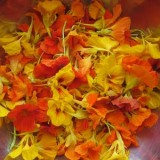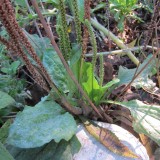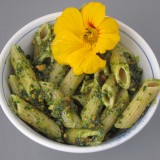 |
| Before. Photo by Bill Wheelock. |
Our neighborhood has an abundance of carob (Ceratonia siliqua) trees that, around this time of year, drop thousands of pounds of pods. Now many of us may have unpleasant associations with carob as a 1970s era chocolate substitute, but the tree has a long history in the Middle East, where it’s used to make a tea, as a source of molasses, as a vegetable and as animal feed. The “locusts” that John the Baptist dined on were not insects but, instead, the pods of the carob tree.
 |
| After. Photo by Bill Wheelock. |
In the Middle East carob has a reputation as a famine food. According to the carob article in Wikipedia the people of Malta ate carob pods and prickly pear fruit during WWII. How appropriate then that my neighbor Bill Wheelock, who just dehydrated a huge batch of my prickly pear fruit (and faced the thorny consequences), took on the onerous task of figuring out how to dry carob pods and process then into a powder using common kitchen appliances. He has authored a handy step by step guide on Instructables on how to process carob.
As a drought tolerant tree that produces hundreds of pounds of pods each year, Ceratonia siliqua definitely should be included in any food forestry plant list for of our Mediterranean climate. So if that quantitative easing thing doesn’t work out, at lease we’ll have the carob and prickly pear.






Wow! I would love to be able to grow a chocolate substitute, but I don’t live in a “mediterranean climate” :).
Thanks for the info. I’m going to do some research to see if the ceratonia siliqua might be interested in making its home in Maine :).
I live around many carob trees here in the Pacific Northwest. Until recently I didn’t know what they were, I just used the pods to entertain my babies on long walks–when the seeds are dry in the pods they make great rattles. A friend from Algeria told me that during the Algerian revolution many survived on carob trees when they were hiding from French troops. Truly, a famine food. I look at these trees a lot differently now when I take my walks.
I’m no expert on this, but if the same (southern) regions of Spain that grow citrus also grow carob, then could potentially parts of Florida be a welcome climate for carob? In north Florida we have much more of a semblance of winter than central or south Florida, which tends to be hotter and wetter anyway.
thanks for posting this 🙂 i would love to make my own carob; i’ve been thinking about it a lot since i recently found and fell in love with teeccino, the ‘herbal cofffee’ made with roasted carob. i know the stuff grows around here (here is maui!), now i just need to find it. aloha
bakerymanis:
I’ve also been pondering the carob powder in light of Teecino–which I like, but which is too expensive. But I’d also have to search out those nuts they use (I think they might be at Mountain Rose Herbs) and then grind up dried figs (sticky!) and most mysteriously, add a dab of coffee flavor. Still, I wonder if I could pull it off, and if it could work out economically.
Paul Thomson the founder of CRFG had a very keen interest in carob. He wrote quite a lengthy tome about it in one of the magazines. If you are interested in the article I can see if I can track it down, make a copy and send it to you.
A guy I know (American) living in the Ukraine wants to show his neighbors how to process carob. Sending him this handy link. THANKS!!